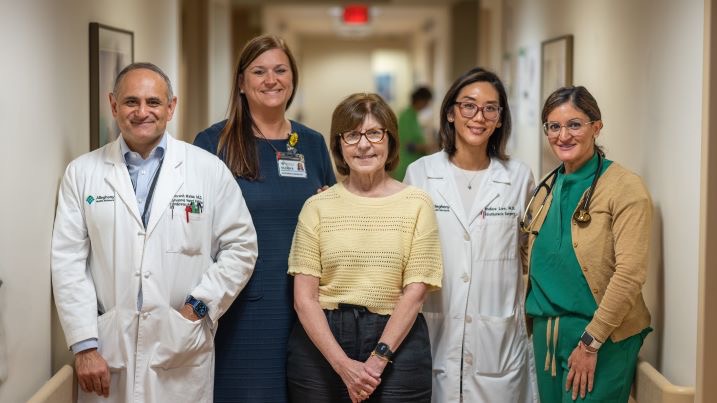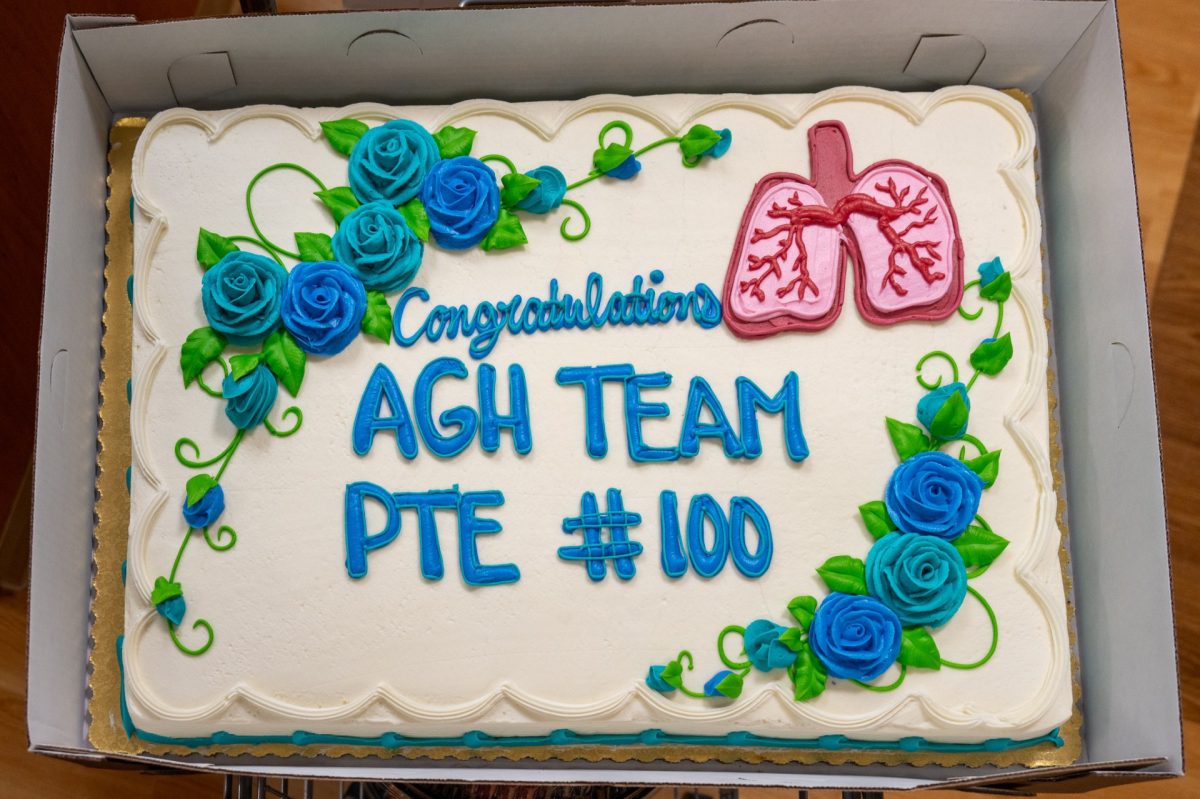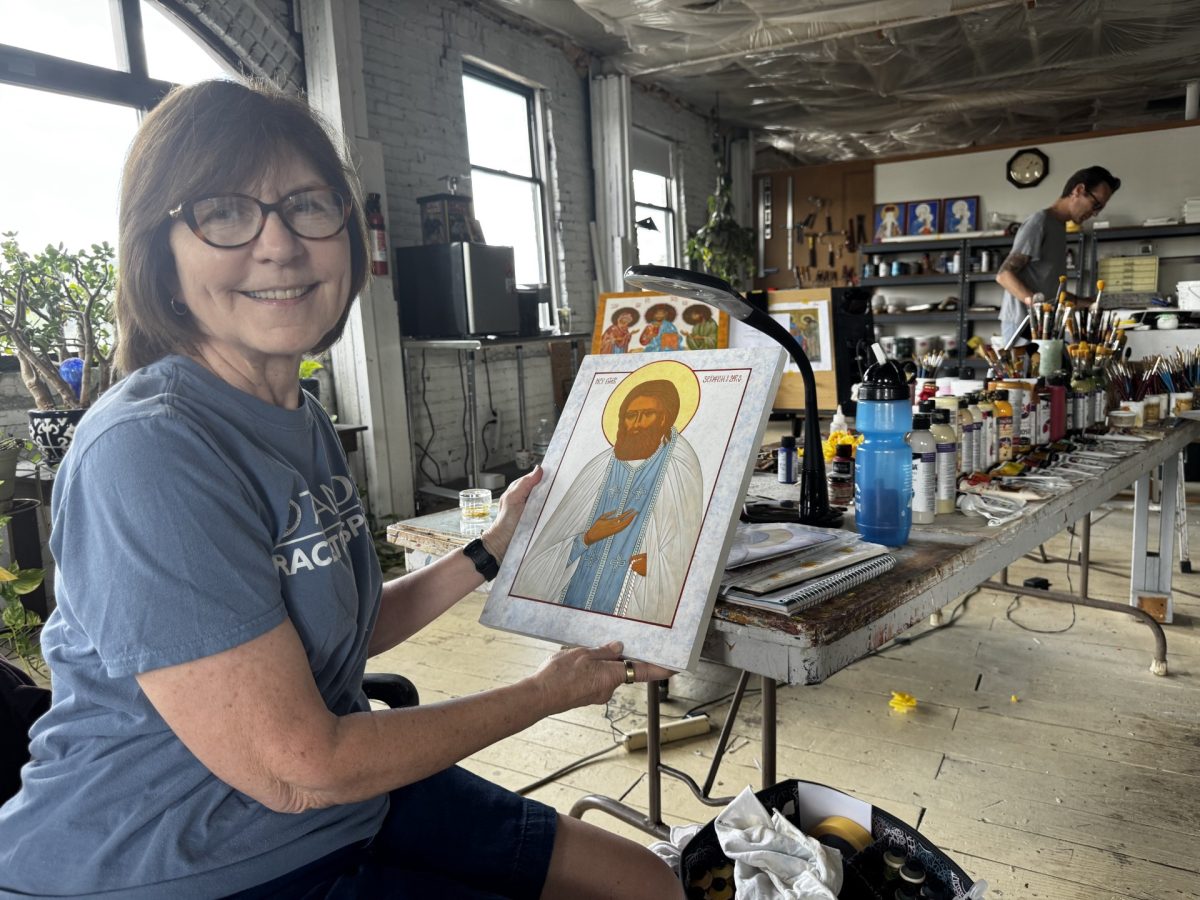Still blooming: Rare lung surgery gives Peters Township woman her life back
Over the years, Mary Ann Reck, a master gardener, has cultivated a beautiful perennial garden in the back yard of her Peters Township home.
It’s filled with vibrant hydrangeas, coneflowers, lavender, peonies, and tulips brought back from a trip to the famous Keukenhof Tulip Gardens in Amsterdam.
But Reck, 72, is disappointed with her garden this year.
“All I’ve cultivated this year are weeds,” said Reck, standing near a shrub of gorgeous, blooming white hydrangeas.
But there’s a reason – besides the summer’s hot weather and heavy rains – that Reck’s garden, still lovely, looks a bit untamed to her.
Diagnosed with a rare, progressive, life-threatening lung condition called CTEPH (Chronic Thromboembolic Pulmonary Hypertension), Reck underwent a complex and challenging surgical procedure on May 7 at AHN Allegheny General Hospital in Pittsburgh.
Reck’s surgery, a pulmonary thromboendarterectomy (PTE), was performed by nationally recognized cardiothoracic surgeon Dr. Candice Lee, who is one of the few surgeons in the country who performs PTEs to treat CTEPH.
It was the 100th PTE successfully completed at Allegheny General Hospital. The surgery is offered at only a handful of hospitals in the United States.
Patients travel from across the country to have their CTEPH treated at Allegheny General Hospital; Reck lives 18 miles away.
“I’m grateful that we have these great hospitals and great resources in Pittsburgh, so close to us,” said Reck. “Being the 100th PTE patient at AGH isn’t the way I want to become a bit of a celebrity, but I am grateful for these doctors.”
CTEPH is a form of high blood pressure in the lungs that develops when blood clots (called pulmonary embolisms) in the lungs don’t dissolve, causing blockages in the artery. Over time, the blockages lead to scar tissue and other changes in the blood vessels in the lungs and makes it difficult for the right heart to pump blood properly, which can weaken the heart muscle.
“The added work on the heart muscle can cause right heart failure, and reduce oxygenated blood flow to the body’s cells, tissues and vital organs,” said Lee. “Although rare, CTEPH can be debilitating, and fatal if left untreated.”
Up to 3,000 cases of CTEPH are diagnosed each year in the U.S. When left untreated, the CTEPH prognosis is poor. The average life expectancy for someone with CTEPH is between one to three years.
Reck was extremely nervous to undergo the surgery, “but I was between a rock and a hard place, but it was my best option and my other options were not good.
“I wanted to get better, so I just had to have faith and put myself in those doctors’ hands and God’s hands, and I went for it. And I was grateful that I had the opportunity for the surgery, because not everybody is qualified,” she said, noting about 30% of people with CTEPH aren’t candidates for PTE.
And Reck had confidence in Lee and the “A Team,” led by Lee.
A long, technical surgery
PTE is a long, technically difficult open-heart surgery that includes heart-lung bypass, a medical feat that makes many of today’s intricate surgeries – like PTE – possible.
During her 10-hour surgery, Reck’s chest was opened and she was connected to a heart-lung bypass machine, which takes over the work of the heart. Her body was then cooled to about 65 degrees Fahrenheit to protect the brain and organs during the operation.
Lee then delicately removed several blood clots from the pulmonary arteries in both of Reck’s lungs before her body was gradually warmed and she was taken off the ventilator.
Speed is crucial. During the periods where the heart-lung machine is turned off and the heart stops beating – which provides a bloodless field for surgeons to work in – surgeons have about 20 minutes for each lung to remove blood clots and scar tissue.
Reck’s surgery was successful.
She spent two weeks in the hospital, including five days in ICU, before returning home.
“I’m feeling good,” said Reck, who is still undergoing cardiac rehab at AHN Canonsburg and will need to continue on blood thinners for life. “I can do practically everything I did before.”
An active lifestyle interrupted
Reck had always been healthy and active.
But in 2022, she ended up with a series of health issues, starting with COVID-19 in June of that year, followed by shingles in December.
Then, in January 2023, on a trip to Oahu, Hawaii, Reck suffered a perforated appendix eight days into the vacation and underwent an emergency appendectomy on the island.
She remained in the hospital for two days before she and her husband, Kevin, who were accompanied by Reck’s cousin, flew home.
At a doctor’s appointment on Feb. 1, her primary care physician, Dr. Vincent Trapanotto of Allegheny Health Network, heard abnormal heart sounds and, suspecting a possible pulmonary embolism, sent her immediately to AHN Canonsburg for diagnostic tests including a chest CT scan.
Tests confirmed a blood clot, and Reck was immediately transferred to AHN Allegheny General and on Feb. 2 – Reck’s 70th birthday – she underwent a thrombectomy, a surgery to remove a blood clot from an artery or vein.
Following the surgery, Reck was placed on a blood thinner for six months to prevent new clots from forming.
“Six months later, I was taken off Eliquis, which is normal procedure, and in 97% of people, that takes care of it. I thought it was taken care of and I could put this behind me,” said Reck.
But about a month later, Reck started experiencing shortness of breath, called her doctor and said she was struggling to breathe.
“They said if I was short of breath, I should get to the hospital,” said Reck.
Her pulmonologist, Allegheny Health Network’s Dr. Raghukumar Thirumala, ordered a series of tests, which showed high pulmonary hypertension.
Additional tests confirmed what Thirumala had suspected: CTEPH.
In about 3% to 5% of people with a pulmonary embolism, clots get stuck in the lungs and remain there long-term. Many people with CTEPH are unaware they have the blood clots, and the disease can progress slowly and silently for months or years.
That’s what happened to Reck.
“It was caused by the blood clots that I had about two years ago which did not resolve after treatment with blood thinners,” Reck said. “Dr. Thirumala was like a detective, and he wouldn’t give up until he figured out what was wrong.”
It was Reck’s son, Chris Weber, and daughter, Cathy Weber, who led her to AGH. Chris contacted Cathy’s best friend, a pharmacist specializing in cardiac and pulmonary hypertension issues who had interned at AGH and connected her with the physicians there, including Lee.
“They’re extremely skilled. Dr. Lee is awesome. She’s patient and attentive, and spent time answering all of my questions,” said Reck. “She’s humble and caring toward her patients, just so nice.”
Dr. Stephen Lee, chair of AHN Cardiovascular Institute, commended Lee and the multidisciplinary team on the milestone 100th PTE that saved Reck’s life.
“We’re extremely proud of Dr. Lee and her exceptional work in this rare field of medicine,” said Lee.
More than three months into her recovery, Reck is spending as much time as she can with the people she loves, doing the things she loves.
She is delighted to be back in her garden, tending to her flowers.
She also has resumed iconography painting, where she is training under the tutelage of iconographer Michael Kapeluck of Sts. Peter and Paul Ukrainian Orthodox Church in Carnegie.
She is thankful for the support she got from her husband, to whom she has been married for 30 years, her children, and her church family at St. John the Baptist Orthodox Church in Canonsburg, near Canonsburg Hospital.
Based on her experience, Reck now tells friends and loved ones to pay attention to their bodies.
“If you’re having symptoms, have them checked out. Don’t wait,” she said. “Being able to do the things I enjoy and be with the people I love brings me joy. I am so happy to still be here.”





